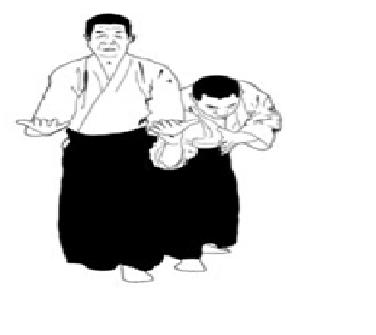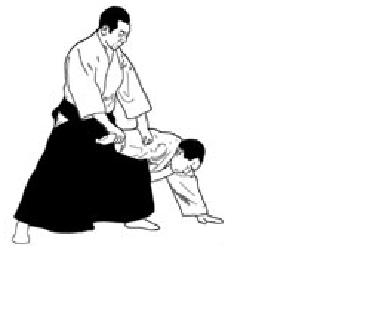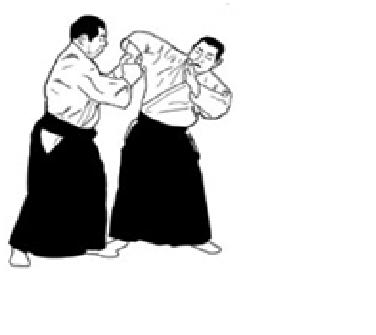|
آی کی دو آی کی کای کاشان
فرهنگی - ورزشی -اجتماعی- علمی آموزشی
My Pick of the Top 20 Core Techniques of AikidoOne of my students asked me to create a list of core aikido techniques that would serve as a guide for a well-rounded curriculum. In response, I have come up with a list of the techniques below which I believe embody the essential principles and techniques of aikido. This selection is, of course, a subjective one, and subject to change. Here are the 20 techniques I have chosen: 1. Tai no henko — One of the three exercises always performed first during practice by Founder Morihei Ueshiba. This exercise teaches the basics of the ura, or “turning” movement of aikido. You step toe-to-toe with uke and pivot to the outside while curling your hand in front of your center.
2. Morotedori Kokyuho — The second of the exercises always practiced by the Founder which involves a kokyunage-like response to a strong two-handed grab. This technique helps develop the ability to blend against a superior physical force, your partner’s two-hand grab against one arm. 3. Shomenuchi Ikkyo omote — Ikkyo is the first of the basic ikkyo-yonkyo arm manipulation series in aikido. The ikkyo movement is performed with you moving in front of uke to apply a horizontal arm pressure, and ends with an ikkyo arm pin. The Founder would initiate this movement against shomenuchi as documented in his 1938 training manual titled “Budo.” Most modern schools practice this technique in response to uke’s striking in contrast to the Founder’s approach. 4. Shomenuchi Ikkyo ura — The ura version of ikkyo teaches how to blend with uke by turning to the outside, followed by an ikkyo pin.
5. Katadori Ikkyo omote — Ikkyo omote performed from the the shoulder grab is different in that you must use your shoulder to establish a blend and gain control of uke’s arm. As you enter, you crouch forward immobilizing uke’s arm against your shoulder to come to the ikkyo position. This technique is very important to learning how to use your shoulders and hips in tandem. 6. Katadori Nikyo omote — Nikyo is the second of the ikkyo-yonkyo series in aikido. A potentially dangerous technique, it must be performed cautiously. I favor locking the wrist in position and inclining the torso forward to apply pressure. This method is very effective, but does not result in injury to uke’s wrist since it is immobilized. A seated pin follows. 7. Katadori Nikyo ura — The ura version of nikyo involves a turning movement, followed by the nikyo seated pin. 8. Katatedori Sankyo omote — Sankyo is the third of the ikkyo-yonkyo series. Performed against a single-hand grab, uke is first unbalanced and secured through a ikkyo movement which is followed by the sankyo pressure, leading to a seated sankyo pin. 9. Katatedori Sankyo ura — The same sankyo with the pin being accomplished through an outward turning movement leading to the seated sankyo pin. 10. Kosadori Yonkyo omote — Yonkyo is the fourth of the ikkyo-yonkyo exercises. Here it is performed from a cross-hand grab and involves a strong pressure against the nerve on the inside of the lower forearm. The yonkyo pin is performed while standing using the entire weight of the body.
11. Kosadori Yonkyo ura — The ura version of yonkyo executed in the same manner with an outward turn into the standing yonkyo pin. 12. Shomenuchi Iriminage — One of the crowing jewels of the aikido curriculum, the Founder initiated the movement against shomenuchi before executing the iriminage throw. This technique teaches very important lessons of footwork and pivoting. The final part of iriminage is performed with a rotational movement of the arm referred to as a “kokyu” movement. A common mistake is not to face in the same direction as uke which leads to an ineffective blend and a clash with uke. 13. Tsuki Iriminage — This technique, although not often practiced, is excellent for developing a response to a rapid thrust or punch followed by iriminage. It can be used in a multiple-attack scenario. One should avoid becoming entangled with uke’s movement and be able to rapidly disengage to deal with other opponents. 14. Yokomenuchi Shihonage omote — Another of the important basics of aikido, the shihonage, or “four-sided” throw, teaches how to vary the direction of the throw depending on the particular set of circumstances. The first part of shihonage should lock uke’s elbow and upper arm. This is often overlooked allowing uke to resist your movement. One then passes through raising uke’s arm as if wielding a sword. The final movement resembles a sword strike and can be secured with a standing or kneeling pin. From yokomenuchi, this technique can be performed by first entering, or alternatively, by stepping to uke’s front to blend and then applying shihonage. 15. Katatedori Kokyunage — Several techniques can be referred to by this name. The variation I am thinking of involves entering to uke’s side and extending your arm across the upper body past the eyes to produce a “flinch response” which uke’s head is jerked backwards. Your forward leg enters diagonally behind your partner for the throw. This is a very important awase, or blending movement. 16. Katatedori Shihonage omote — Another possible application of shihonage from a single-hand grab. The whole body should work as a unit to first unbalance uke by establishing an armbar, followed by the shihonage throw. A good exercise is to throw uke in different directions to practice turning while controling uke’s body. 17. Ryotedori Tenchinage — The so-called “heaven-and-earth” throw of aikido, this is a rather complex movement requiring a great deal of coordination. It is a study in contrast as you must blend with uke using both arms simultaneously. One hand enters downward while the other hand, executing a kokyu movement, spirals upward. Step through to uke’s side to complete the throw. 18. Munadori Kotegaeshi — The munadori, or chest grab, is a simple way of teaching someone the all-important kotegaeshi wrist turn technique which is ubiquitous in aikido. One avoids the grab turning outward with the feeling of cutting to the outside and rear. Having established a blend with uke, kotegaeshi can then be applied. It should not be necessary to force uke down using pain compliance. Your blending movement must unbalance uke to the point that he falls easily when his wrist is held. 19. Ushiro ryotedori Ikkyo omote — This technique is performed when both your hands are grabbed from behind. Raising and extending your hands forward and up, you unbalance uke. The same basic ikkyo omote movement can be applied from there. See the Shomenuchi ikkyo technique above. 20. Suwariwaza Kokyuho — The third of the three exercises performed by the Founder at the end of each class. This exercise teaches how to blend when both hands are held. You must make your body into a single unit, leading with your hips and guiding the movement through the subtle use of your hands. It is important not to tense up or resort to physical force in an attempt to push uke over. I might suggest a very good technical book titled “Takemusu Aikido: Background & Basics” by Morihiro Saito for those who would like more information on this subject. Finally, I would invite you to contribute your list of the core techniques of aikido. As I wrote above, this is a highly subjective thing, and will also vary from style to style. I look forward to reading your comments!
چهار شنبه 18 آذر 1394برچسب:, :: 13:31 :: نويسنده : تای شا
موضوعات آخرین مطالب آرشيو وبلاگ پيوندها نويسندگان |
||
|
|




 آمار
وب سایت:
آمار
وب سایت: